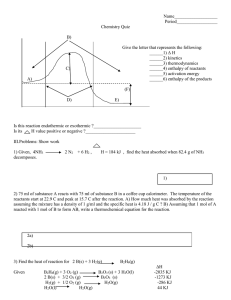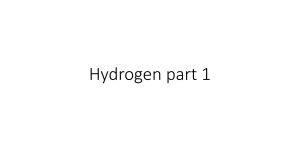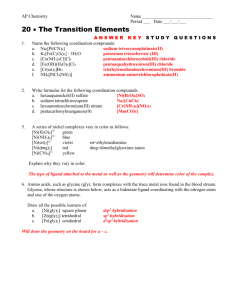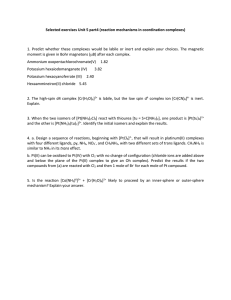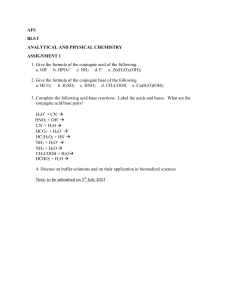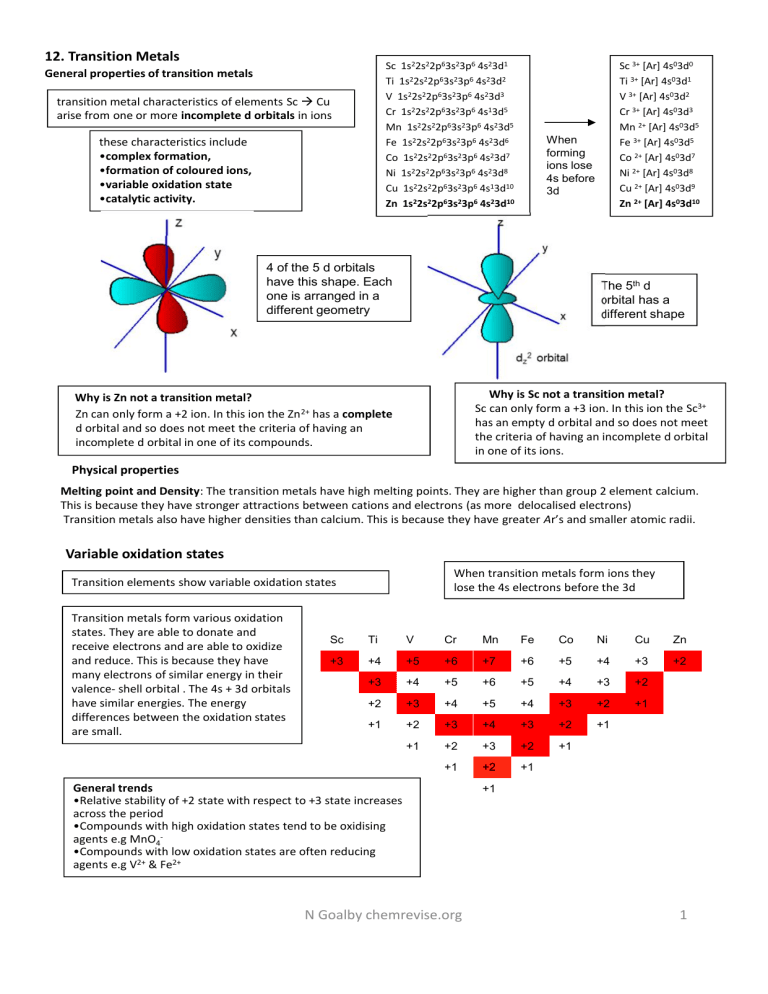
12. Transition Metals Sc 1s22s22p63s23p6 4s23d1 Ti 1s22s22p63s23p6 4s23d2 V 1s22s22p63s23p6 4s23d3 Cr 1s22s22p63s23p6 4s13d5 Mn 1s22s22p63s23p6 4s23d5 Fe 1s22s22p63s23p6 4s23d6 Co 1s22s22p63s23p6 4s23d7 Ni 1s22s22p63s23p6 4s23d8 Cu 1s22s22p63s23p6 4s13d10 Zn 1s22s22p63s23p6 4s23d10 General properties of transition metals transition metal characteristics of elements Sc Cu arise from one or more incomplete d orbitals in ions these characteristics include •complex formation, •formation of coloured ions, •variable oxidation state •catalytic activity. Sc 3+ [Ar] 4s03d0 Ti 3+ [Ar] 4s03d1 V 3+ [Ar] 4s03d2 Cr 3+ [Ar] 4s03d3 Mn 2+ [Ar] 4s03d5 Fe 3+ [Ar] 4s03d5 Co 2+ [Ar] 4s03d7 Ni 2+ [Ar] 4s03d8 Cu 2+ [Ar] 4s03d9 Zn 2+ [Ar] 4s03d10 When forming ions lose 4s before 3d 4 of the 5 d orbitals have this shape. Each one is arranged in a different geometry The 5th d orbital has a different shape Why is Sc not a transition metal? Sc can only form a +3 ion. In this ion the Sc3+ has an empty d orbital and so does not meet the criteria of having an incomplete d orbital in one of its ions. Why is Zn not a transition metal? Zn can only form a +2 ion. In this ion the Zn 2+ has a complete d orbital and so does not meet the criteria of having an incomplete d orbital in one of its compounds. Physical properties Melting point and Density: The transition metals have high melting points. They are higher than group 2 element calcium. This is because they have stronger attractions between cations and electrons (as more delocalised electrons) Transition metals also have higher densities than calcium. This is because they have greater Ar’s and smaller atomic radii. Variable oxidation states When transition metals form ions they lose the 4s electrons before the 3d Transition elements show variable oxidation states Transition metals form various oxidation states. They are able to donate and receive electrons and are able to oxidize and reduce. This is because they have many electrons of similar energy in their valence- shell orbital . The 4s + 3d orbitals have similar energies. The energy differences between the oxidation states are small. Sc Ti V Cr Mn Fe Co Ni Cu Zn +3 +4 +5 +6 +7 +6 +5 +4 +3 +2 +3 +4 +5 +6 +5 +4 +3 +2 +2 +3 +4 +5 +4 +3 +2 +1 +1 +2 +3 +4 +3 +2 +1 +1 +2 +3 +2 +1 +1 +2 +1 General trends •Relative stability of +2 state with respect to +3 state increases across the period •Compounds with high oxidation states tend to be oxidising agents e.g MnO4•Compounds with low oxidation states are often reducing agents e.g V2+ & Fe2+ N Goalby chemrevise.org +1 1 Complex formation complex :is a central metal ion surrounded by ligands. 2+ OH2 ligand.: An atom, ion or molecule which can donate a lone electron pair. H2O Co-ordinate bonding is involved in complex formation. Co-ordinate bonding is when the shared pair of electrons in the covalent bond come from only one of the bonding atoms. Co-ordination number: The number of co-ordinate bonds formed to a central metal ion. H2O Cu OH2 OH2 OH2 Ligands can be monodentate (e.g. H2O, NH3 and Cl- ) which can form one coordinate bond per ligand or bidentate (e.g. NH2CH2CH2NH2 and ethanedioate ion C2O4 2- ) which have two atoms with lone pairs and can form two coordinate bonds per ligand or multidentate (e.g. EDTA4- which can form six coordinate bonds per ligand). Reaction of copper and cobalt complexes Metal aqua ions are formed in aqueous solution. [Cu(H2O)6]2+ is a blue solution [Co(H2O)6]2+ is a pink solution Reaction with limited amount of OH- and limited NH3 The bases OH- and ammonia when added to aqueous complexes in limited amounts form the hydroxide precipitates. They form in deprotonation acid base reactions Cu(OH)2(H2O)4 (s) blue ppt, Co(OH)2(H2O)4 (s) blue ppt, [Cu(H2O)6]2+ (aq) + 2OH- (aq) Cu(H2O)4(OH)2 (s) + 2H2O (l) [Co(H2O)6]2+ (aq) + 2OH- (aq) Co(H2O)4(OH)2 (s) + 2H2O (l) [Cu(H2O)6]2+ (aq) [Cu(H2O)6]2+ (aq) + 2NH3 (aq) Cu(H2O)4(OH)2 (s) + 2NH4+ (aq) + 2NH3 (aq) Cu(H2O)4(OH)2 (s) + 2NH4+ (aq) Here the NH3 and OH- ions are acting as Bronsted-Lowry bases accepting a proton Ligand Exchange Reactions If excess ammonia is added to cobalt and copper aqueous ions a ligand exchange reaction occurs The ligands NH3 and H2O are similar in size and are uncharged. Exchange of the ligands NH3 and H2O occurs without change of co-ordination number (eg Co2+ and Cu2+). [Co(H2O)6]2+(aq) + 6NH3 (aq) [Co(NH3)6]2+(aq) + 6H2O (l) A pale yellow solution This substitution may, however, be incomplete as in the case with Cu. The equation can also be written from the hydroxide precipitate [Cu(H2O)6]2+(aq) + 4NH3 (aq) [Cu(NH3)4(H2O)2]2+ (aq) + 4H2O (l) A deep blue solution Cu(OH)2(H2O)4(s) + 4NH3 (aq) [Cu(NH3)4(H2O)2]2+ (aq) + 2H2O (l) + 2OH- (aq) Reactions with Chloride Ions Addition of a high concentration of chloride ions (from conc HCl or saturated NaCl) to an aqueous ion leads to a ligand exchange reaction. The Cl- ligand is larger than the uncharged H2O and NH3 ligands so therefore ligand exchange can involve a change of coordination number. Addition of conc HCl to aqueous ions of Cu and Co lead to a change in coordination number from 6 to 4. These are [CuCl4]2- yellow/green solution tetrahedral in [CoCl4]2- blue solution shape Be careful: If solid copper chloride (or any other metal) is dissolved in water it forms the aqueous [Cu(H2O)6]2+ complex and not the chloride [CuCl4]2- complex. N Goalby chemrevise.org [Cu(H2O)6]2+ + 4Cl- [CuCl4]2- + 6H2O [Co(H2O)6]2+ + 4Cl- [CoCl4]2- + 6H2O 2 Bidentate Ligands Ligands can be bidentate (e.g. NH2CH2CH2NH2 and ethanedioate ion C2O4 2- ) which have two atoms with lone pairs and can form two coordinate bonds per ligand Ethane-1-2-diamine 3+ CH2 NH2 H2 C NH2 CH2 NH2 Cr NH2 NH2 NH2 H2 C CH2 Ethane-1-2-diamine is a common bidentate ligand. A complex with Ethane-1-2diamine bidentate ligands e.g. [Cr(NH2CH2CH2NH2)3]3+ Ethanedioate C2O4 2- O 3- C O O C O O Cr CH2 O C There are 3 bidentate ligands in this complex each bonding in twice to the metal ion. C O O A complex with bidentate ethanedioate ligands e.g. [Cr(C2O4)3]3- O C O O C Octahedral shape with 90o bond angles O It has a coordination number of 6 Equations to show formation of bidentate complexes Cu(H2O)62+ + 3NH2CH2CH2NH2 [Cu(NH2CH2CH2NH2)3]2+ + 6H2O Cu(H2O)62+ + 3C2O42- [Cu(C2O4)3]4- + 6H2O Partial substitution of ethanedioate ions may occur when a dilute aqueous solution containing ethanedioate ions is added to a solution containing aqueous copper(II) ions. In this reaction four water molecules are replaced and a new complex is formed. 2OH2 O C O O Cu C C O O O O C O OH2 Cu(H2O)62+ + 2C2O42- [Cu(C2O4)2(H2O)2]2- + 4H2O Multidentate Ligands Ligands can be multidentate (e.g. EDTA4- which can form six coordinate bonds per ligand). The EDTA4- anion has the formula O -O C CH2 N -O C O CH2 Equations to show formation of mutidentate complexes Cu(H2O)62+ + EDTA4- [Cu(EDTA)]2- + 6H2O O CH2 C O- CH2 C CH2 CH2 N Learn the two bidentate ligands mentioned above but it is not necessary to remember the structure of EDTA. O- O with six donor sites(4O and 2N) and forms a 1:1 complex with metal(II) ions N Goalby chemrevise.org 3 Manganate Redox Titration The redox titration between Fe2+ with MnO4– (purple) is a very common exercise. This titration is self indicating because of the significant colour change from reactant to product. MnO4-(aq) + 8H+ (aq) + 5Fe2+ (aq) Mn2+ (aq) + 4H2O (l) + 5Fe3+ (aq) Purple colourless The purple colour of manganate can make it difficult to see the bottom of meniscus in the burette. If the manganate is in the burette then the end point of the titration will be the first permanent pink colour. Colourless purple Choosing correct acid for manganate titrations. The acid is needed to supply the 8H+ ions. Some acids are not suitable as they set up alternative redox reactions and hence make the titration readings inaccurate. Only use dilute sulphuric acid for manganate titrations. Insufficient volumes of sulphuric acid will mean the solution is not acidic enough and MnO 2 will be produced instead of Mn2+. MnO4-(aq) + 4H+(aq) + 3e- MnO2 (s) + 2H2O The brown MnO2 will mask the colour change and lead to a greater (inaccurate) volume of Manganate being used in the titration. Using a weak acid like ethanoic acid would have the same effect as it cannot supply the large amount of hydrogen ions needed (8H+). It cannot be conc HCl as the Cl- ions would be oxidised to Cl2 by MnO4- as the Eo MnO4-/Mn2+ > Eo Cl2/ClMnO4-(aq) + 8H+(aq) + 5e– Mn2+ (aq) + 4H2O(l) E+1.51V Cl2(aq) +2e– 2Cl–(aq) E +1.36V This would lead to a greater volume of manganate being used and poisonous Cl 2 being produced. It cannot be nitric acid as it is an oxidising agent. It oxidises Fe 2+ to Fe3+ as Eo NO3-/HNO2> Eo Fe3+/Fe2+ NO3- (aq) + 3H+(aq) + 2e– HNO2(aq) + H2O(l) Eo +0.94V 3+ – 2+ Fe (aq)+e Fe (aq) Eo +0.77 V This would lead to a smaller volume of manganate being used. Be able to perform calculations for these titrations and for others when the reductant and its oxidation product are given. Manganate titration example A 2.41g nail made from an alloy containing iron is dissolved in 100cm3 acid. The solution formed contains Fe(II) ions. 10cm3 portions of this solution are titrated with potassium manganate (VII) solution of 0.02M. 9.80cm3 of KMnO4 were needed to react with the solution containing the iron. What is the percentage of Iron by mass in the nail? MnO4-(aq) + 8H+(aq) + 5Fe2+ Mn2+(aq) + 4H2O + 5Fe3+ Step1 : find moles of KMnO4 moles = conc x vol 0.02 x 9.8/1000 = 1.96x10-4 mol Step 2 : using balanced equation find moles Fe2+ in 10cm3 = moles of KMnO4 x 5 = 9.8x10-4 mol Step 3 : find moles Fe2+ in 100cm3 = 9.8x10-4 mol x 10 = 9.8x10-3 mol Step 4 : find mass of Fe in 9.8x10-3 mol mass= moles x RAM = 9.8x10-3 x 55.8 = 0.547g Step 5 : find % mass %mass = 0.547/2.41 x100 = 22.6% N Goalby chemrevise.org 4 With ethanedioate Ox C2O42- 2CO2 + 2eRed MnO4-(aq) + 8H+(aq) + 5e- Mn2+ (aq) + 4H2O Overall 2MnO4-(aq) + 16H+(aq) + 5C2O42-(aq) 10CO2(g) + 2Mn2+(aq) + 8H2O(l) With Iron (II) ethanedioate both the Fe2+ and the C2O42- react with the MnO41MnO4- reacts with 5Fe2+ and 2 MnO4- reacts with 5C2O42MnO4-(aq) + 8H+(aq) + 5Fe2+ Mn2+ (aq) + 4H2O + 5Fe3+ 2MnO4-(aq) + 16H+(aq) + 5C2O42- 10CO2 + 2Mn2+ (aq) + 8H2O So overall 3MnO4-(aq) + 24H+(aq) + 5FeC2O4 10CO2 + 3Mn2+ (aq) + 5Fe3+ + 12H2O The reaction between MnO4- and C2O42- is slow to begin with (as the reaction is between two negative ions). To do as a titration the conical flask can be heated to 60o C to speed up the initial reaction. So overall the ratio is 3 MnO4- to 5 FeC2O4 Step1 : find moles of KMnO4 moles = conc x vol 0.0189 x 23.45/1000 = 4.43x10-4 mol Step 2 : using balanced equation find moles FeC2O4.2H2O in 25cm3 = moles of KMnO4 x 5/3 (see above for ratio) = 7.39x10-4 mol Step 3 : find moles FeC2O4.2H2O in 250 cm3 = 7.39x10-4 mol x 10 = 7.39x10-3 mol Step 4 : find mass of FeC2O4.2H2O in 7.39x10-3 mol mass= moles x Mr = 7.39x10-3 x 179.8 = 1.33g A 1.412 g sample of impure FeC2O4.2H2O was dissolved in an excess of dilute sulphuric acid and made up to 250 cm3 of solution. 25.0 cm3 of this solution decolourised 23.45 cm3 of a 0.0189 mol dm–3 solution of potassium manganate(VII). What is the percentage by mass of FeC2O4.2H2O in the original sample? Step 5 ; find % mass %mass = 1.33/1.412 x100 = 94.1% Reducing Chromium Cr3+ (green) and then Cr2+ (blue) are formed by reduction of Cr2O72(orange) by the strong reducing agent zinc in (HCl) acid solution. Fe2+ is a less strong reducing agent and will only reduce the dichromate to Cr3+ The Fe2+ and Cr2O7 2- in acid solution reaction can be used as a quantitative redox titration. This does not need an indicator Cr2O72- + 14H+ + 3Zn 2Cr3+ + 7H2O + 3 Zn2+ Cr2O72- + 14H+ + 4Zn 2Cr2+ + 7H2O + 4 Zn2+ Keeping the zinc/dichromate under a hydrogen atmosphere is needed to reduce it to Cr2+, because O2 in air will oxidise Cr2+ up to Cr3+ Cr2O72- + 14H+ + 6Fe2+ 2Cr3+ + 7H2O + 6 Fe3+ Orange green Redox Potentials Cr2O72- + 14H+ + 6e- 2Cr3+ + 7H2O E +1.33V Fe3+(aq) + e– Fe2+(aq) E +0.75V Cr3+(aq) + e– Cr2+(aq) E -0.41V Zn2+ + 2e- Zn E=-0.76V The electrode potential of Iron(II) is in between the two chromium half equations, so Fe2+ will reduce chromium down to Cr3+ As zinc has a more negative electrode potential than all the chromium half equations, zinc will reduce chromium down to Cr2+ N Goalby chemrevise.org 5 Shapes of complex ions transition metal ions commonly form tetrahedral complexes with larger ligands (e.g.Cl- ). [CoCl4]2- transition metal ions commonly form octahedral complexes with small ligands (e.g. H2O and NH3). [Co(NH3)6]2 [Cu(H2O)6]2+ H3 N NH3 Ni H3 N Cl 2+ NH3 square planar complexes are also formed, e.g. cisplatin 2- H 3N Ag+ commonly forms linear complexes e.g. [Ag(NH3)2]+ used as Tollen’s Reagent Cl Pt Cu H 3N NH3 NH3 Cl + H3 N Cl Ag NH3 Cl Cl Isomerism in complex ions Complexes can show two types of stereoisomerism: cis-trans isomerism and optical isomerism Cis-trans isomerism in square planar complexes H3N H3N NH 3 Ni Cl Cl Ni Cl Cl cis–trans isomerism is a special case of E–Z isomerism NH 3 trans-Ni(NH3)2Cl2 Cis-Ni(NH3)2Cl2 Cis-trans isomerism in octahedral complexes OH2 HCl 2+ OH2 + H2O ClH ClH Cr Cr H2O OH2 + 2+ HCl OH2 OH2 OH2 trans-[Cr(H2O )4Cl2]+ Cis-[Cr(H2O )4Cl2]+ Optical isomerism in octahedral complexes Complexes with 3 bidentate ligands can form two optical isomers (non-superimposable mirror images). 2+ 2+ CH2 H2C NH2 H2N NH2 NH2 CH2 Ni NH2 NH2 H2C CH2 CH2 H2C NH2 H2C NH2 Ni CH2 - NH2 NH2 NH2 CH 2 CH2 NH2 CH2 N Goalby chemrevise.org 6 Cisplatin The Pt(II) complex cisplatin is used as an anticancer drug. The cisplatin version only works as two chloride ions are displaced and the molecule joins on to the DNA. In doing this it stops the replication of cancerous cells. - H3N Cl Pt - 2+ H3N cisplatin NH3 Cl Pt - Cl H3N 2+ - Cl transplatin Cisplatin prevents DNA replication in cancer cells by a ligand replacement reaction with DNA in which a dative covalent bond is formed between platinum and a nitrogen atom on guanine NH3 O Pt NH3 N NH NH N NH 2 The N and O atoms marked in red can’t bond to cis-platin as they are involved in the bonding within the DNA Cisplatin can also prevent the replication of healthy cells by bonding on to healthy DNA which may lead to unwanted side effects like hair loss. Society needs to assess the balance between the benefits and the adverse effects of drugs, such as the anticancer drug cisplatin. N Goalby chemrevise.org 7 Formation of coloured ions Colour changes arise from changes in 1. oxidation state, 2. co-ordination number 3. ligand. O2 [Co(NH3)6]2+ (aq) [Co(NH3)6]3+ (aq) +eyellow brown Co(H2O)62+ + 4Cl- [CoCl4]2- + 6H2O pink blue In this equation only oxidation state is changing. Co(H2O)62+ + 6 NH3 Co(NH3)62+ + 6H2O Pink yellow brown In this equation both ligand and coordination number are changing. In this equation only the ligand is changing. How colour arises Degenerate d orbitals split into two energy levels octahedral and tetrahedral complexes Colour arises from electronic transitions from the ground state to excited states: between different d orbitals. A portion of visible light is absorbed to promote d electrons to higher energy levels. The light that is not absorbed is transmitted to give the substance colour. Equation to learn! This equation links the colour and frequency of the light absorbed with the energy difference between the split d orbitals. E = hv. v = frequency of light absorbed (unit s-1 or Hz) h= Planck’s constant 6.63 × 10–34 (J s) E = energy difference between split orbitals (J) Degenerate means all orbitals have the same energy Average energy of degenerate d orbitals in field of ligands dx2- y 2 dz2 E dxy dxz dyz Octahedral complex ion Ligands cause the 5 d orbitals to split into two energy levels. A solution will appear blue if it absorbs orange light. The energy split in the d orbitals E will be equal to the frequency of orange light(5 x1014 s-1) x Planck’s constant E in a blue solution = hv = 6.63 × 10–34 x 5 x1014 = 3.32 × 10–19 J Changing colour Changing a ligand or changing the coordination number will alter the energy split between the d- orbitals, changing E and hence change the frequency of light absorbed. Compounds without colour Scandium is a member of the d block. Its ion (Sc3+) hasn't got any d electrons left to move around. So there is not an energy transfer equal to that of visible light. In the case of Zn2+ ions and Cu+ ions the d shell is full e.g.3d10 so there is no space for electrons to transfer. Therefore there is not an energy transfer equal to that of visible light. Spectrophotometry If visible light of increasing frequency is passed through a sample of a coloured complex ion, some of the light is absorbed. The amount of light absorbed is proportional to the concentration of the absorbing species (and to the distance travelled through the solution). Some complexes have only pale colours and do not absorb light strongly. In these cases a suitable ligand is added to intensify the colour. Absorption of visible light is used in spectrometry to determine the concentration of coloured ions. method •Add an appropriate ligand to intensify colour •Make up solutions of known concentration •Measure absorption or transmission •Plot graph of absorption vs concentration •Measure absorption of unknown and compare Spectrometers contain a coloured filter. The colour of the filter is chosen to allow the wavelengths of light through that would be most strongly absorbed by the coloured solution. N Goalby chemrevise.org 8 Stability of complexes The substitution of monodentate ligand with a bidentate or a multidentate ligand leads to a more stable complex. This is called the chelate effect This chelate effect can be explained in terms of a positive entropy change in these reactions as more molecules of products than reactants [Cu(H2O)6]2+ (aq) + EDTA4- (aq) [Cu (EDTA)]2- (aq) + 6H2O (l) The copper complex ion has changed from having unidentate ligands to a multidentate ligand. In this reaction there is an increase in the entropy because there are more moles of products than reactants (from 2 to 7), creating more disorder. The enthalpy change is small as there are similar numbers of bonds in both complexes. Free energy ΔG will be negative as ΔS is positive and ΔH is small. The stability of the EDTA complexes has many applications. It can be added to rivers to remove poisonous heavy metal ions as the EDTA complexes are not toxic. It is in many shampoos to remove calcium ions present in hard water, so helping lathering. [Co(NH3)6]2+ + 3NH2CH2CH2NH2 [Co(NH2CH2CH2NH2)3]2+ + 6NH3 This reaction has an increase in entropy because of the increase in moles from 4 to 7 in the reaction. ΔS is positive. Its enthalpy change ΔH is close to zero as the number of dative covalent and type (N to metal coordinate bond) are the same so the energy required to break and make bonds will be the same. Therefore Free energy ΔG will be negative and the complex formed is stable. Stability constants Kstab A ligand exchange reaction is considered as equilibria then an equilibrium expression can be written Kstab = [CuCl42- aq] . [Cu(H2O)6 aq2+] [Cl- aq]4 [Cu(H2O)6]2+ + 4Cl- ⇌ [CuCl4]2- + 6H2O H2O is not included in the expression because it is concentration is assumed to be constant. The value of K is called the stability constant for complex ions. The larger the stability constant the more stable the complex ion. A complex ion with a small stability constant will not displace the ligand from a more stable complex ion with a larger stability constant. eg adding ammonia to a complex ion of copper and edta will not result in a colour change N Goalby chemrevise.org Ligand Log Kstab Cl- 5.62 NH3 13.1 Edta4- 18.8 9
